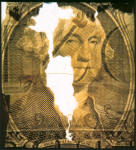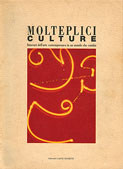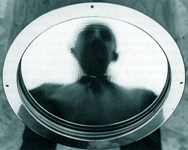|
“ Paolo Monti ”
by Massimo Carboni
in
Multiple Cultures. Itineraries of contemporary art in a changing
world
MOLTEPLICI CULTURE
Itinerari dell’arte contemporanea in un mondo che cambia
ROMA-MUSEO DEL FOLKLORE
Convent of S. Egidio, Rome
19 May – 19 June 1992
MASSIMO CARBONI / PAOLO MONTI
The recovery of an artistic project through the use of materials and
processes typical of technology is at the heart of Paolo Monti’s work,
that therefore enters into a historically well-defined arena. No
ideology, no pathetic intention of “saving” technics and making them more
“human” and “creative”. The technological dimension is used merely as an
instrument to fix possible images: images that can maintain open, with
themselves the possibility of self-transformation. In this occasion,
Monti has chosen to work conceptually and materially on money, image of
the Same and of the Other, repetition and difference taken in the
vertigo of their Value. 1.
 The image of a bill is projected onto a pane of sanded glass. Within the
slide a chemical solution, activated by the heat produced by the
projector when it is turned on, slowly corrodes the paper that is
inserted within. “The exchange value of goods, with its own peculiar
existence next to the goods themselves”, wrote K. Marx in Grundrisse,
“is money”; it is the form in which all goods are dissolved, that which
is dissolved in all goods; it is the general equivalent”. Monti’s work
is at once the paraphrase and reversal of Marx’ thesis. Money is not
assumed as form of means and therefore as universal equivalent, but as
material subjected to a specific process of wasting: but it dissolves
not in the goods but in itself. Money is not naturally an object endowed
with value, its quality consists only in its quantity. Monti
materializes abstract value, overturns the process that brings to
general equivalence and brings money back to its initial condition of
object. In an “X” time, the time in which the projector is turned on and
the image is visible, the bill will be dissolved. There will be no
trace left, bundled off by chemical reagents. “Time is money”: here it
is money that it is time. Until total entropy is reached, until the
final consummation: as if in accelerated and contracted terms its own
nihilistic nature were presented. “Money calls for money”: it attracts
only itself, wants only itself in a coercion to repeat that always finds
the Identical in the Other. Until the end. The image of a bill is projected onto a pane of sanded glass. Within the
slide a chemical solution, activated by the heat produced by the
projector when it is turned on, slowly corrodes the paper that is
inserted within. “The exchange value of goods, with its own peculiar
existence next to the goods themselves”, wrote K. Marx in Grundrisse,
“is money”; it is the form in which all goods are dissolved, that which
is dissolved in all goods; it is the general equivalent”. Monti’s work
is at once the paraphrase and reversal of Marx’ thesis. Money is not
assumed as form of means and therefore as universal equivalent, but as
material subjected to a specific process of wasting: but it dissolves
not in the goods but in itself. Money is not naturally an object endowed
with value, its quality consists only in its quantity. Monti
materializes abstract value, overturns the process that brings to
general equivalence and brings money back to its initial condition of
object. In an “X” time, the time in which the projector is turned on and
the image is visible, the bill will be dissolved. There will be no
trace left, bundled off by chemical reagents. “Time is money”: here it
is money that it is time. Until total entropy is reached, until the
final consummation: as if in accelerated and contracted terms its own
nihilistic nature were presented. “Money calls for money”: it attracts
only itself, wants only itself in a coercion to repeat that always finds
the Identical in the Other. Until the end.
2.
 A report. The operation was planned in the following terms. The
opening
day of the exhibition, a truck should have transported a large sum of
money in bills (two or three billion Lire) to the place of the
exhibition. An armed convoy should have placed the contents of the
special suitcases on the round, forming a regular parallelepiped with
the piles of bills, for a certain fixed length of time (5 minutes – half
an hour). Exhibition, epiphany of pure value, absolute coincidence of
reality (the concreteness of reality) and phantasy (all the goods and
services and materials – bodies, diamonds, information – buyable with
that sum). The bank Pio X had agreed: written requests and clarification
were sent, specific meetings of the Board of Directors were held.
Although efforts were made by supportive officials and directors, it was
not possible to realize the project. Problems of security, trade union
problems, difficulties due to un-modifiable automatism of the timer of
the bank vault. What does all this mean? It is the confirmation of what
early 20th century German sociology – from Rimmel to Weber - pointed
out: the progressive abstraction and intellectualization of social
relations, alienated by the real subject. The technical and
bureaucratic-administrative has its own and independent life,
impermeable and separate from the will of individuals. The anomalous
request, undecodeable in its logic, stalls the apparatus. The criticality
of art today consists precisely in the homeopathic injection of
anomalies that makes the system slip by using its own weapons: it
transforms it into other, into idea, even if it remains the same. A report. The operation was planned in the following terms. The
opening
day of the exhibition, a truck should have transported a large sum of
money in bills (two or three billion Lire) to the place of the
exhibition. An armed convoy should have placed the contents of the
special suitcases on the round, forming a regular parallelepiped with
the piles of bills, for a certain fixed length of time (5 minutes – half
an hour). Exhibition, epiphany of pure value, absolute coincidence of
reality (the concreteness of reality) and phantasy (all the goods and
services and materials – bodies, diamonds, information – buyable with
that sum). The bank Pio X had agreed: written requests and clarification
were sent, specific meetings of the Board of Directors were held.
Although efforts were made by supportive officials and directors, it was
not possible to realize the project. Problems of security, trade union
problems, difficulties due to un-modifiable automatism of the timer of
the bank vault. What does all this mean? It is the confirmation of what
early 20th century German sociology – from Rimmel to Weber - pointed
out: the progressive abstraction and intellectualization of social
relations, alienated by the real subject. The technical and
bureaucratic-administrative has its own and independent life,
impermeable and separate from the will of individuals. The anomalous
request, undecodeable in its logic, stalls the apparatus. The criticality
of art today consists precisely in the homeopathic injection of
anomalies that makes the system slip by using its own weapons: it
transforms it into other, into idea, even if it remains the same.
3.
 The bills’ acceptor through an internal optic mechanism, select images
that are proposed according to the sole image memorized in its program.
If the bill is not perfect, it refuses it but doesn’t give it back: the
interaction is dominated by the machine. It is the technological
incarnation of the purity of money-value that recognizes only identity
with itself through the total exclusion of the Other. The image of the
bill that the “acceptor” keeps in memory is the performance itself of
the image: that is, it is the image of absolute perfection, prodigy of
banality, ecstasies of the identical. Every game has its rules; but
exhibiting the rules means to change the game. The bills’ acceptor through an internal optic mechanism, select images
that are proposed according to the sole image memorized in its program.
If the bill is not perfect, it refuses it but doesn’t give it back: the
interaction is dominated by the machine. It is the technological
incarnation of the purity of money-value that recognizes only identity
with itself through the total exclusion of the Other. The image of the
bill that the “acceptor” keeps in memory is the performance itself of
the image: that is, it is the image of absolute perfection, prodigy of
banality, ecstasies of the identical. Every game has its rules; but
exhibiting the rules means to change the game.
4. Multiculturalism is a belief, if the fact is left unprejudiced that the
pure value (abstract and not ethnic) of money, and the planetary power
balances that it produces, homogenizes all centrifugal tendencies,
rationalizes differences and brings everything back to zero. For this
reason, even multiculturalism could be an ideology of consolation
allowed to exist by the apparatus because totally inoffensive and
ineffectual. There is a true multiculturalism of the dominant system
cemented by economical and financial power. Otherwise it is just talk.
There is multiculturalism only if it is not “separate” culture anymore,
but rather antagonist political practice on a planetary level.
 “PAOLO
MONTI” “PAOLO
MONTI”
by Massimo Carboni
in:
Molteplici Culture -
Itinerari
dell'arte contemporanea in un mondo che cambia -
Multiple Cultures -
Itineraries of contemporary art in a changing world
Rome, Carte Segrete Editore
1992,
pp. 12,14,148,149,150,171
|

